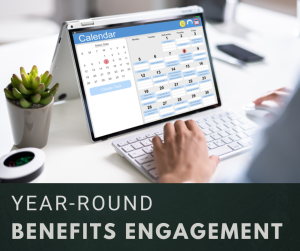 Most organizations treat employee benefits like a seasonal event. Open enrollment brings a flurry of activity – emails, seminars, and even benefits fairs. However, communication often dwindles after this initial push, leaving employees confused and underutilizing their valuable benefits.
Most organizations treat employee benefits like a seasonal event. Open enrollment brings a flurry of activity – emails, seminars, and even benefits fairs. However, communication often dwindles after this initial push, leaving employees confused and underutilizing their valuable benefits.
This is a missed opportunity. Research shows that employees crave more benefits education, spending hours researching their options. By proactively engaging employees throughout the year, organizations can:
- Improve Employee Understanding: Ongoing communication helps employees retain information and make informed decisions, rather than relying solely on a single, overwhelming open enrollment period.
- Reduce Confusion & Mistakes: Employees often make costly mistakes, such as under-saving for healthcare expenses or failing to utilize valuable benefits like employee assistance programs. Consistent communication can help them avoid these pitfalls.
- Boost Benefits Utilization: Regular reminders encourage employees to actively use their benefits, such as gym memberships, financial counseling, or legal services, leading to improved well-being and reduced stress.
- Enhance Employee Engagement: When employees understand and utilize their benefits, they experience increased job satisfaction, reduced stress levels, and improved overall well-being, leading to higher productivity and retention rates.
- Gain Valuable Insights: Year-round communication allows HR teams to gather valuable data through employee surveys and feedback, enabling them to refine their communication strategies and better address employee needs.
Building a Successful Communication Plan
Two primary approaches can guide your communication strategy:
- Calendar-Based: This traditional approach focuses on pre-determined themes for each quarter or month, aligning with seasonal trends and employee needs. For example, Q1 might focus on retirement planning, Q2 on health and wellness, Q3 on family-related benefits, and Q4 is Open Enrollment season.
- Action-Based: This more modern approach triggers communication-based on employee actions, such as when they file a claim or contribute to their Health Savings Account (HSA). This ensures communication is most relevant when employees are actively engaged with their benefits.
Key Considerations:
- Go Beyond the Booklet: Get creative with your content! Repurpose your open benefits booklet and enrollment presentations into a variety of formats. Utilize diverse communication channels, such as emails, podcasts, newsletters, intranet resources, text messages, and interactive online tools to make information easily accessible.
- Focus on Employee Needs: Tailor your communication to address specific employee concerns and questions, such as how to reduce healthcare costs or plan for retirement.
- Measure and Refine: You can’t manage what you can’t measure. Be sure to track the effectiveness of your communication efforts through surveys, employee feedback, and utilization data. Use these insights to refine your strategy and improve employee engagement.
Benefits education is communicating information about available benefits in ways that employees can connect to and understand. Communicating benefits information year-round is important because employees’ lives – and their situations – are constantly changing. They get married, divorced, adopt a child or have medical challenges arise.
If employees are engaged with their benefits throughout the year, they are more likely to value and use their benefits and will be better informed about their decisions and/or changes they need to make during the next Open Enrollment period!


